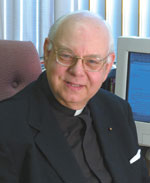Second Sunday of Lent / Msgr. Owen F. Campion
The Sunday Readings
 The Book of Genesis is the source of the first reading for Mass this weekend. Genesis is often associated with its creation narratives.
The Book of Genesis is the source of the first reading for Mass this weekend. Genesis is often associated with its creation narratives.
Much else is included in Genesis. A major figure in it is Abraham. Historians and biblical scholars agree that Abraham lived long ago. He was not a myth or the product of imagination.
Historically, Jews have regarded Abraham as the first of their race. In a theological sense, Christians see Abraham as the first of their community of believers also because Christianity flows from the revelation initially given by God to the ancient Hebrews.
This weekend’s reading is familiar. Abraham leads his beloved son Isaac to the top of a high mountain to kill him as a sacrifice to God. As it is well known, God intervenes and orders that Isaac be spared.
The story has several lessons. One lesson, usually overlooked, is the repudiation of human sacrifice by none other than God himself. Beyond this detail, this reference shows that paganism in any form is a human invention.
God illuminated the people. He rescued them by drawing them away from paganism and leading them to the truth. Abraham was God’s instrument. Abraham’s faith made him worthy to be God’s instrument.
For Christians, Isaac symbolizes Jesus, since Jesus was the victim of the ignorance and viciousness of pagan humans. Jesus, however, ultimately rose to a new and unending life.
St. Paul’s Epistle to the Romans furnishes the second reading. This reading simply says that if the power and light of God are with us, nothing can prevail against us.
The Gospel of St. Mark provides the last reading. It is the story of the transfiguration.
Jesus takes Peter, James and John to the summit of a high mountain. There, in an overwhelming, stupendous, even terrifying appearance, Jesus is transfigured, visible to the Apostles as the Son of God.
Light is everywhere. In the Old Testament, God is associated with light. Indeed, we associate darkness with danger and the unknown. Light is from God, as are security, strength, genuine awareness and perception.
Mountaintops have been seen as places on Earth nearest to heaven. In a hopeful, awkward attempt to come as close as possible to God, humans went to the tops of mountains. Indeed, the temple in Jerusalem was at the summit of Mount Zion. Jesus was crucified on a hilltop. He ascended from a hilltop.
In this reading, Jesus appears in the reality of his divinity. In this divinity is eternal life itself. God never dies. God never changes. Nothing daunts God. Nothing threatens God. These notions about God pertained to the hearts and minds of Jews of Jesus’ time as they do for us in modern times and theology.
The presence of Moses and Elijah with Jesus on the mountaintop is important. Their places on either side of the Lord indicate that Jesus stands in the historic train of God’s communication with and salvation of his people, a process in salvation history in which Moses and Elijah were vitally important.
Reflection
Lent continues. The Church leads us in this period to prepare us for Holy Week and Easter.
Its message is simple. We humans are utterly limited and we can never overcome our limitations. But God provides for us just as he long ago provided for Abraham, whose faith was unflinching.
Gifted with faith, we can see God in Jesus, just as the Apostles saw Jesus in the transfiguration. See Jesus as the shining example, the unfailing, everlasting light of our personal world.
Allow others to be transfigured. See in every human being the Lord.
Faith brings us wonderous, revealing, inspiring insight. We see God in the life of Jesus, in the mercy of Jesus. We see in all others cherished brothers and sisters of Jesus, blessed by God, redeemed by Jesus, due our respect and love. †
 The Book of Genesis is the source of the first reading for Mass this weekend. Genesis is often associated with its creation narratives.
The Book of Genesis is the source of the first reading for Mass this weekend. Genesis is often associated with its creation narratives.